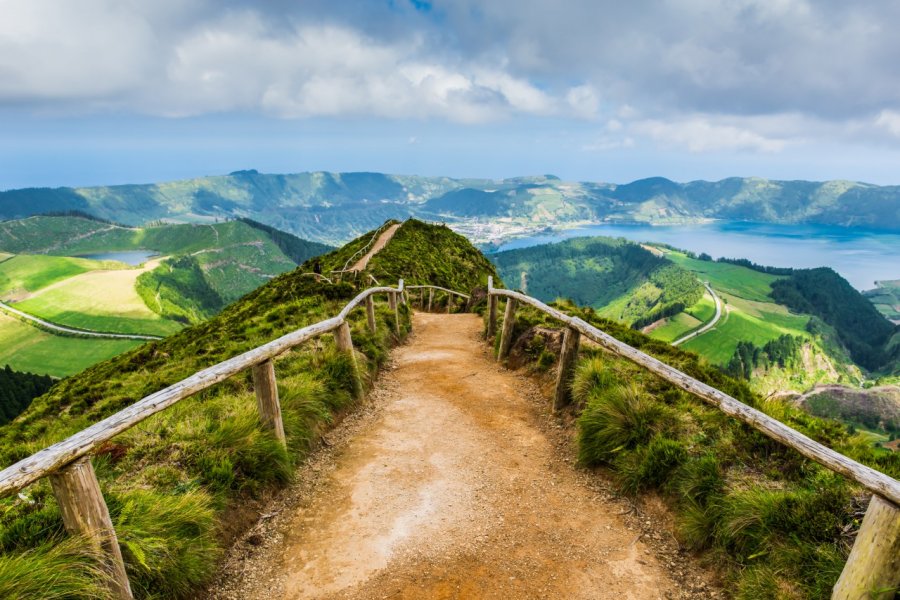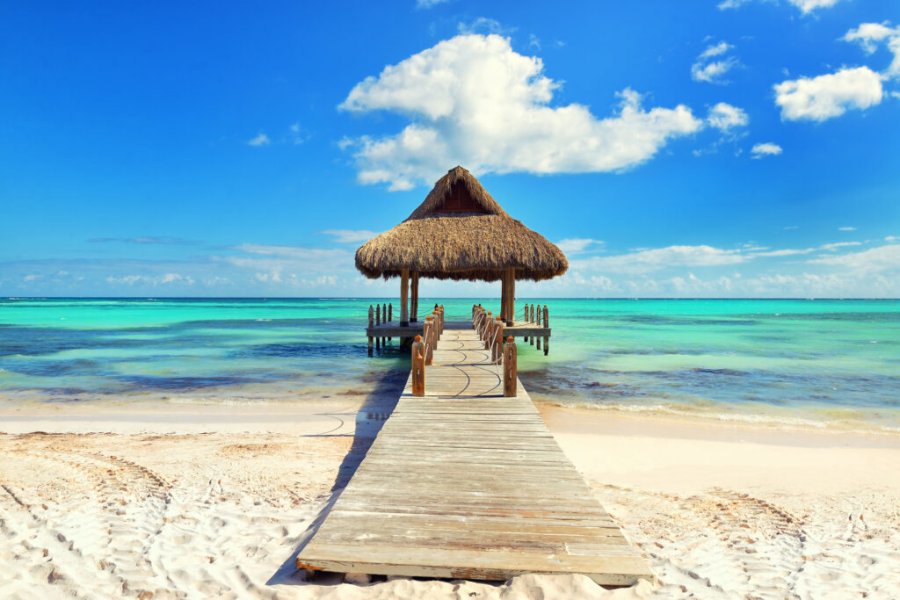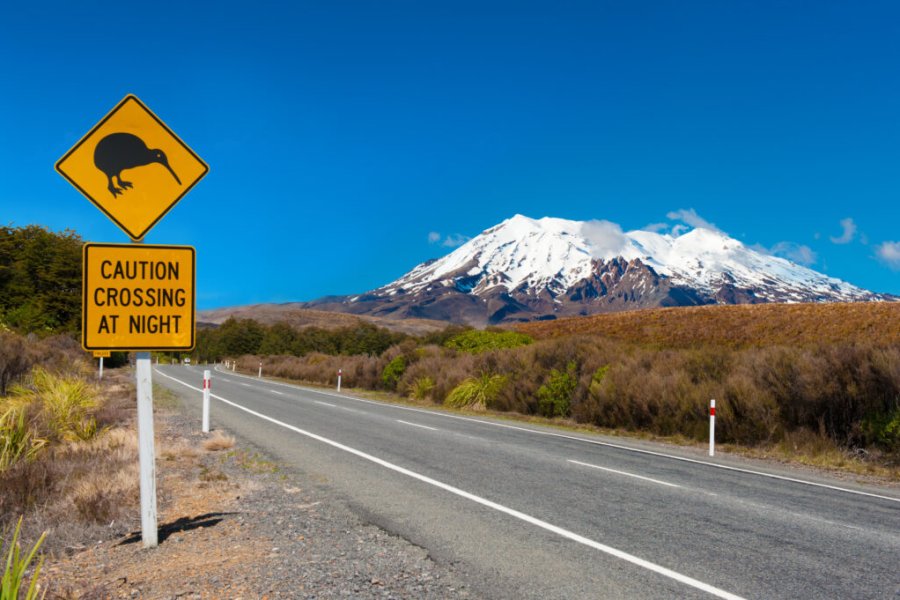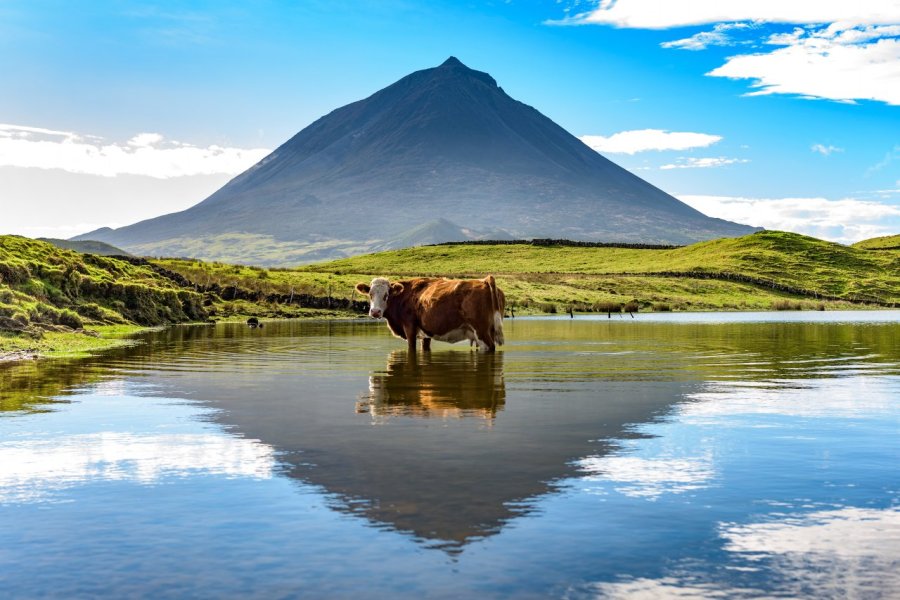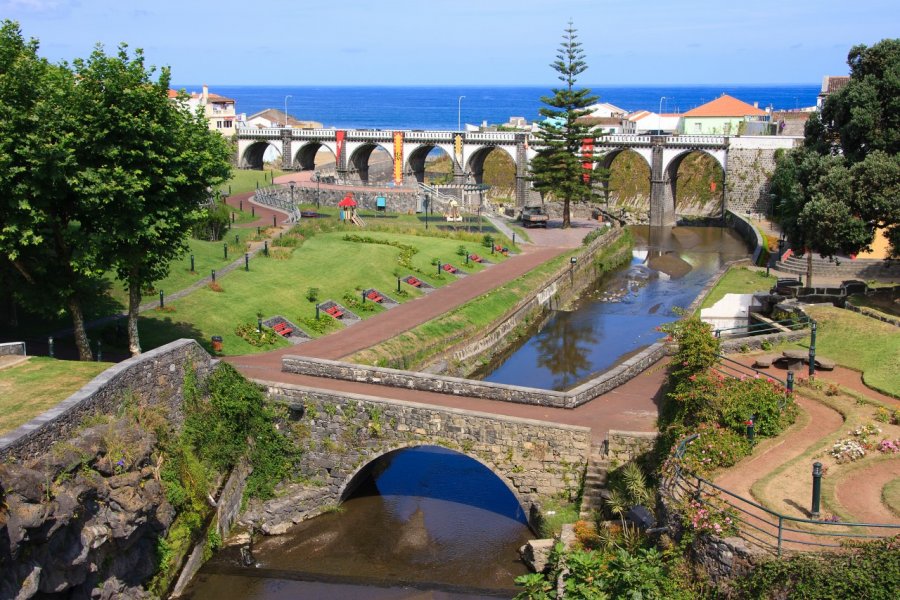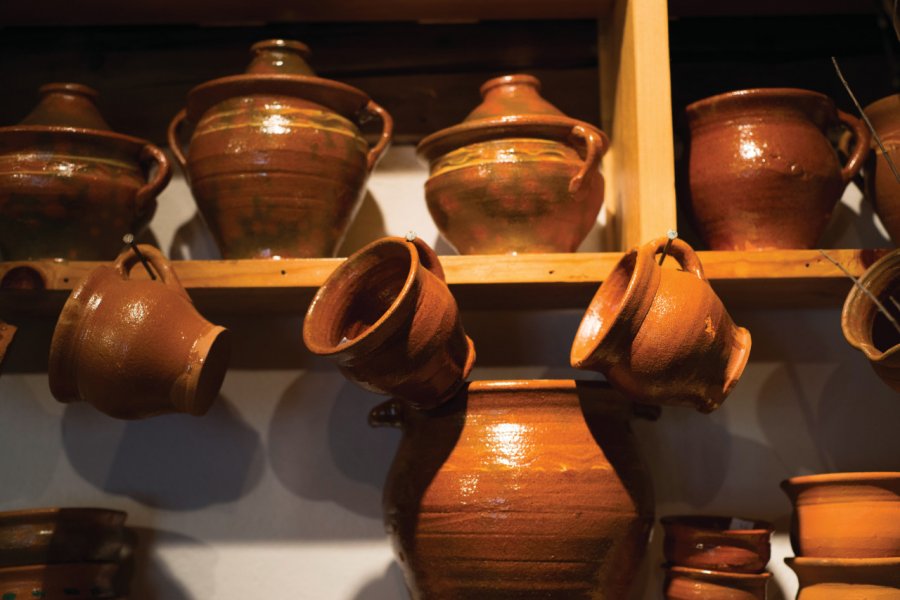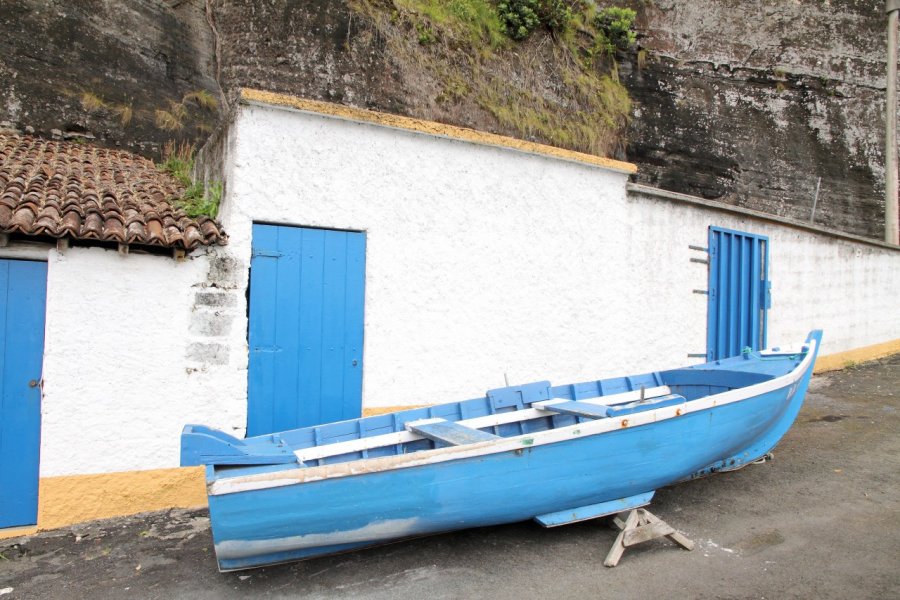Travel guide The Azores
The Azores archipelago is an autonomous region of Portugal located two hours flight from Lisbon in the North Atlantic Ocean. It will delight lovers of hiking and wilderness, far from the crowds of mass tourism. This still unknown destination is declined in nine islands of volcanic origin which have each their dominant color (blue island of Faial, black island of Pico, green island of São Miguel, red island of São Jorge...) according to their geological characteristics. From São Miguel, the big island with twin lakes, to the tiny Corvo, from the Pico volcano, the highest point of the archipelago (2 351 m) to the geothermally heated natural pools of Ponta da Ferraria, the program of escapades is of a formidable wealth. Travel from island to island in the Azores tourist guide amidst thousands of hydrangeas, to the immense caldera of Faial, the black sand beaches of Ribeira Quente, the endless chasms of Terceira, the dizzying waterfalls of Flores, the turquoise blue lagoon of Santo Cristo, the luxuriant garden of Terra Nostra, without forgetting to stop at the world famous port of Horta, to stroll through the streets full of history ofAngra do Heroísmo or to observe the cetaceans that cruise in the area.
What to see, what to do The Azores?
-
Book an activity
-
Customized travel
- The most beautiful cities The Azores
When to go The Azores ?
The best time to go to the Azores is between May and September: the weather is rather stable, it is hot, the sea is at an ideal temperature. To enjoy the advantages of summer while avoiding, as far as possible, its disadvantages, the months of May, June, and September are to be preferred. That said, winter can also bring its share of good surprises to the Azores: from December to February, camellias are in bloom, azaleas brighten the landscape in February and there are even fewer tourists on the islands.
Suggested addresses The Azores
Travel The Azores
-
Find a hotel
-
Car Rental
-
International e-SIM package
-
Find a local agency
The Azores are made up of nine islands, which implies some compromises in terms of transport. Not to mention the climatic conditions which can sometimes delay - or even cancel - a plane or a boat, and cause precious time to be lost in transfers. In winter, the weather is the main enemy, but in summer the flights are quickly full and it is wise to book your seats well in advance. To make matters worse, the summits may still be under the mist and thwart your plans... Making a choice is therefore inevitable: it is impossible to visit the whole archipelago in a week, or even a fortnight, even if it seems conceivable. It would be such a pity to run after the watch in such a peaceful environment! In order to make the most of the wonderful hikes, it is recommended to stay for a good while in the same place. Nature is only known by walking, let's never forget it.
Find unique holiday offers with our partners
How to go The Azores
How to go alone
The nine islands each have an airport. The most important is João Paulo II, located on the island of São Miguel. There are no or very few direct flights to the Azores, regardless of the departure destination. After a stopover in Lisbon or Porto, you can land at Ponte Delgada (São Miguel Island), Horta (Faial Island), Madalena (Pico Island) or Lajes (Terceira Island).
How to go on a tour
Numerous agencies organize customized tours in all the islands of the archipelago, as well as thematic stays. Some of them offer twelve-day trekking and whale watching tours on the islands of Faial, São Jorge, Pico and São Miguel. You can also opt for a diving trip. Online platforms of personalized travel can also put you directly in touch with a local guide before departure, in order to create a tailor-made trip.
How to get around
There are many regular sea and air connections between the nine islands. However, a trip to the Azores cannot be improvised, neither in winter nor in summer. It is more prudent to plan inter-island trips and to anticipate the fact that planes, boats and car rentals may be full. On land, the bus network is not very dense and the best solution is to rent a car because the roads are paved and in good condition.
Featured articles The Azores
Discover The Azores
In the middle of the Atlantic Ocean, halfway between America and Europe, the nine islands of the archipelago have a singular character. Everywhere the ocean, fringed with the foam of its waves, gives a glimpse of the infinite. A true ecological paradise, the Azores are a haven of peace whose colors fascinate the traveler. The multiple shades of green of the islands are enhanced here and there by the persistent blue of the hydrangeas that line the roads and paths. All the colors are amplified by the sun that pierces the clouds. The volcanic origins of the archipelago offer spectacular landscapes, from the caldera of Sete Cidades to the 2,351 meters of Mount Pico. Jagged basalt coasts and emerald lakes will delight the hiker in search of a wild and preserved nature. Everywhere, among the innumerable treasures that each of the islands conceals, there is a treasure that you will have to go and flush out.
Pictures and images The Azores
The 12 keywords The Azores
1. #Pineapple

Introduced by Portuguese settlers, the pineapple has become the flagship of Azorean agriculture and the symbol of the archipelago, particularly São Miguel. It is smaller than the African or Caribbean pineapple. Its acidity, more marked than that of its Caribbean cousin, enhances its aroma and makes it one of the best fruits that can be tasted here.
2. #Anticyclone
The Azores anticyclone, whose name is often mentioned in weather reports, is, like the morning fog, sometimes dissipated. When it's centered right on the archipelago, it's no guarantee of good weather there; it's better if it's just a little bit off. On the other hand, it is a barrier against bad weather and rain in Europe.
3. #Whales

The mythical animal of the Azores, the whale - or more precisely the sperm whale - was still hunted in 1987, especially on the islands of the central group. Today, they are protected and mostly observed by tourists. Horta is the best place for this activity; the marine corridor of the central archipelago is the richest in sperm whales.
4. #Colors
Each island is associated with a color that reflects its characteristics and history. São Miguel is known as the green island, Faial is blue, Graciosa is dressed in white, Santa Maria sees life in pink, Flores wears a yellow jersey, it's brown for São Jorge and lilac for Terceira, while Corvo is gray and Pico is draped in black.
5. #Dragonnier
A spectacular tree with red sap and medicinal virtues (hence its name, associated with dragon's blood), often a hundred years old, highly protected by the locals, originally from Cape Verde. Visible along roadsides, it is a symbol of the absence of pollution. The main square in Santa Cruz de Graciosa boasts an exceptional and magnificent collection.
6. #Churches
There's no shortage of churches here! It seems that for the Portuguese, any opportunity was a good one to build one. When they set out to discover the world, every time they set foot on land, a church popped up. When they survived a storm, a church. To make up for not having mercy on the pirates, a church..
7. #Cheese
A culinary pride of place, particularly in São Jorge, where the succulent baked cow's milk cheese comes from. Similar to Gouda, and very tasty, it undoubtedly has its origins in the know-how of the archipelago's Dutch settlers. Visit one of the agricultural cooperatives to discover its manufacturing secrets and go shopping!
8. #Hortensias
Originally from Asia and introduced to the island by the Portuguese, this magnificent grove of pink, lilac and violet flowers has become a veritable mascot of the archipelago. Hydrangeas lend their unusual, romantic character to the island's landscapes. They bloom from late May to late August and can reach colossal sizes.
9. #Mills

The many mills on the Azores bear architectural witness to the arrival of the first settlers from Flanders. They vary from island to island, and often have a surprisingly northern feel for these subtropical islands. You'll come across them on a hike to Graciosa or Faial, for example, and notice their red domes.
10. #Hikes
Putting on your sneakers and taking to the trails of the Azores is one of the activities that will leave you with the most beautiful memories. Marked trails, close proximity to towns and villages: nature, volcanoes, lakes and waterfalls lend themselves perfectly to hiking and walking. There's something for everyone on each of the nine islands.
11. #Tea
Surprising as it may seem, the Azores are the only place in Europe where tea is grown. Perceived as a sensible alternative to orange cultivation, which was in serious crisis in the 19th century, the first plantations were established in São Miguel. Today, two factories open their doors to you, in Porto Formoso and Maia.
12. #Volcanoes

The tectonic activity is felt everywhere in the Azores! Volcanism has left fascinating traces here: Mount Pico, the highest point in Portugal at 2,351 meters; on São Miguel, the fumaroles of Furnas lake or the crater lakes of Fogo or Sete Cidades are marvels. On Faial, the volcano of Capelinhos was born... in 1958!
You are from here, if...
If you stop in the middle of the road: traffic is calm on most of the archipelago's islands, so locals don't ask questions and stop where they need to stop! That is, most of the time, right in the middle of the road.
If you've downloaded the "Windy" app on your phone : we can't tell you enough, the weather is fickle in the Azores, and the best way to find out what color the sky is and how strong the wind is, is to follow the weather conditions on the "Windy" app. All locals refer to it. Even if it's not infallible, it's still the most accurate way of finding out when and where the rain will make its appearance!
If you're traveling with cabin baggage only: suitcases that don't arrive at the same time as you do are more than common in the Azores. Here, you travel with hand luggage, which you keep carefully with you.

